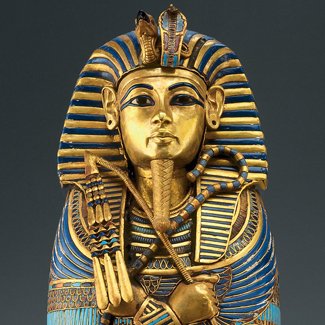Tutankhamun
Tutankhamun

Tutankhamun, the 11th pharaoh of the 18th dynasty of Ancient Egypt, was unremarkable, is famous due to the discovery of his completely intact tomb by the British archaeologist Howard Carter in 1922.
The discovery of Tutankhamun's mummy revealed that he was about 17 when he died and was likely to have inherited the throne at the age of eight or nine. He is thought to have been the son of Akhenaten, commonly known as the 'heretic king'. Akhenaten replaced the traditional cult of 'Amun' with his solar deity 'Aten', thus asserting his authority as pharaoh in a new way.
According to the most important document of Tutankhamun's reign, the Restoration Stele, his father's supposed reforms left the country in a bad state. Consequently the traditional gods, seeing their temples in ruins and their cults abolished, had abandoned Egypt to chaos. When Tutankhamun came to the throne, his administration restored the old religion and moved the capital from Akhetaten back to its traditional home at Memphis. He changed his name from Tutankhaten - 'living image of Aten [the sun god]' - to Tutankhamun, in honour of Amun. His queen, Ankhesenpaaten, the third daughter of Akhenaten and Nefertiti, also changed the name on her throne to read Ankhesenamun.
Although the reign of Tutankhamun is often thought to have little historical importance, his monuments tell a different story. He began repairing the damage inflicted upon the temples of Amun during Akhenaten's iconoclastic reign. He constructed his tomb in the Valley of the Kings, near that of Amenophis III, and one colossal statue still survives of the mortuary temple he began to build at Medinet Habu. He also continued construction at the temple of Karnak and finished the second of a pair of red granite lions at Soleb.
Uncertainty still surrounds his death. He may have been assassinated, or died as the result of an injury received while hunting.
Information retrieved from: https://www.bbc.co.uk/history/historic_figures/tutankhamun.shtml
A more in depth article about King Tut's life and death:
Tutankhamun: The Life & Death of the Boy Pharaoh
Pictures of King Tut's tomb:



Interesting article about the restoration of Tutankhamun's tomb https://www.bbc.co.uk/news/world-middle-east-47077663
Exploring Tut's tomb: https://www.youtube.com/watch?v=Avqafc6fZwc
Jewelery found in Tut's tomb: https://www.youtube.com/watch?v=2OfP8Z5LUS0
These inspired me to sketch a few of my own jewellery designs:

Inspired by pictures of Tut's tomb and coffin I thought I'd attempt to make a paper version of it. Here's the template I used:
I also wanted to print this out out as well but the link was corrupted... I ended up using it as inspiration for the one I managed to print out.
I decided to stop my research about paper engineering here because I felt like it wasn't something I wanted to do in the long term with this project.
Exploring Tut's tomb: https://www.youtube.com/watch?v=Avqafc6fZwc
Jewelery found in Tut's tomb: https://www.youtube.com/watch?v=2OfP8Z5LUS0
These inspired me to sketch a few of my own jewellery designs:
King Tut - The Boy King's Treasures https://www.youtube.com/watch?v=4Hyqwnmnbew
After doing this bit of research, the idea of Tutankhamun being named 'The Boy King' reminded me of this animated series I used to watch as a kid, called 'Tutenstein'.

Tutenstein is an American children's animated television series, produced by Porchlight Entertainment for Discovery Kids based on the comics by Jay Stephens. The half-hour series features young mummy Tutankhensetamun (based on real-life Tutankhamun and usually called "Tutenstein" as in the title) who is awakened about 3,000 years after his accidental death and now must face the fact that his kingdom is gone. The name is a portmanteau of Tutankhamun and Frankenstein.
Link to the first episode of the animated series: https://www.youtube.com/watch?v=2z-sVl04-Gw
This has inspired me to create my own version of young Tutankhamun and furthermore explore the personality he could have if he lived in the present day. (Please refer to sketchbook!)
Artwork inspired by Tutankhamun found on DeviantArt and a few other websites:
 |
Request-Tutankhamunby KINOKO19 |
 |
| Illustrator unknown |
Inspired by pictures of Tut's tomb and coffin I thought I'd attempt to make a paper version of it. Here's the template I used:
My attempt:
I decided to stop my research about paper engineering here because I felt like it wasn't something I wanted to do in the long term with this project.















Comments
Post a Comment